Organizational Behavior Research
VerifiedAdded on 2020/06/05
|14
|4764
|443
AI Summary
This assignment explores key themes in organizational behavior through a selection of academic articles. It delves into topics such as organizational change, the role of anger in workplace dynamics, consumer behavior towards charities, and the impact of workplace health promotion. Additionally, it examines the influence of organizational culture on child sexual abuse prevention and analyzes boundary control in technology use at work. The assignment encourages critical analysis of these diverse research examples within the field of organizational behavior.
Contribute Materials
Your contribution can guide someone’s learning journey. Share your
documents today.
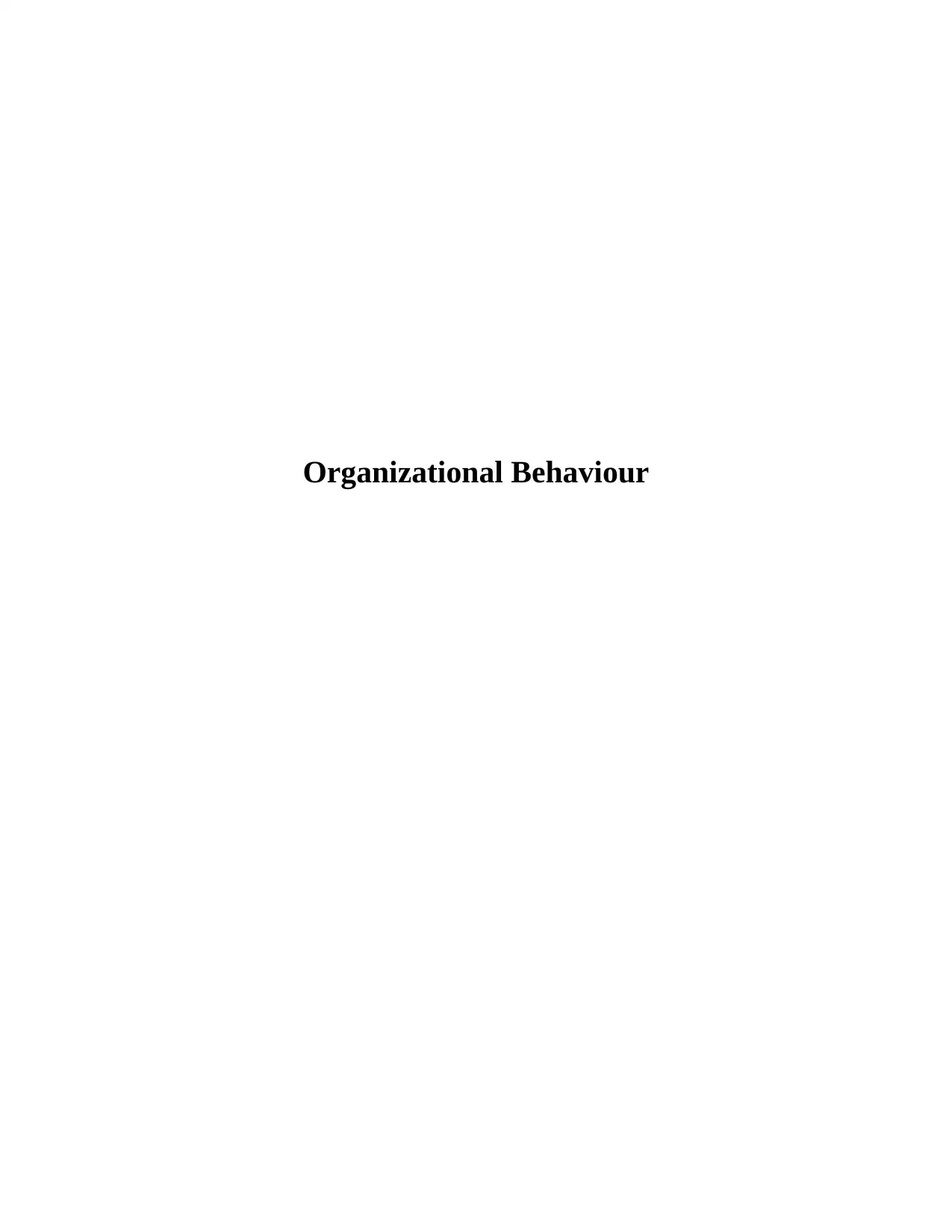
Organizational Behaviour
Secure Best Marks with AI Grader
Need help grading? Try our AI Grader for instant feedback on your assignments.
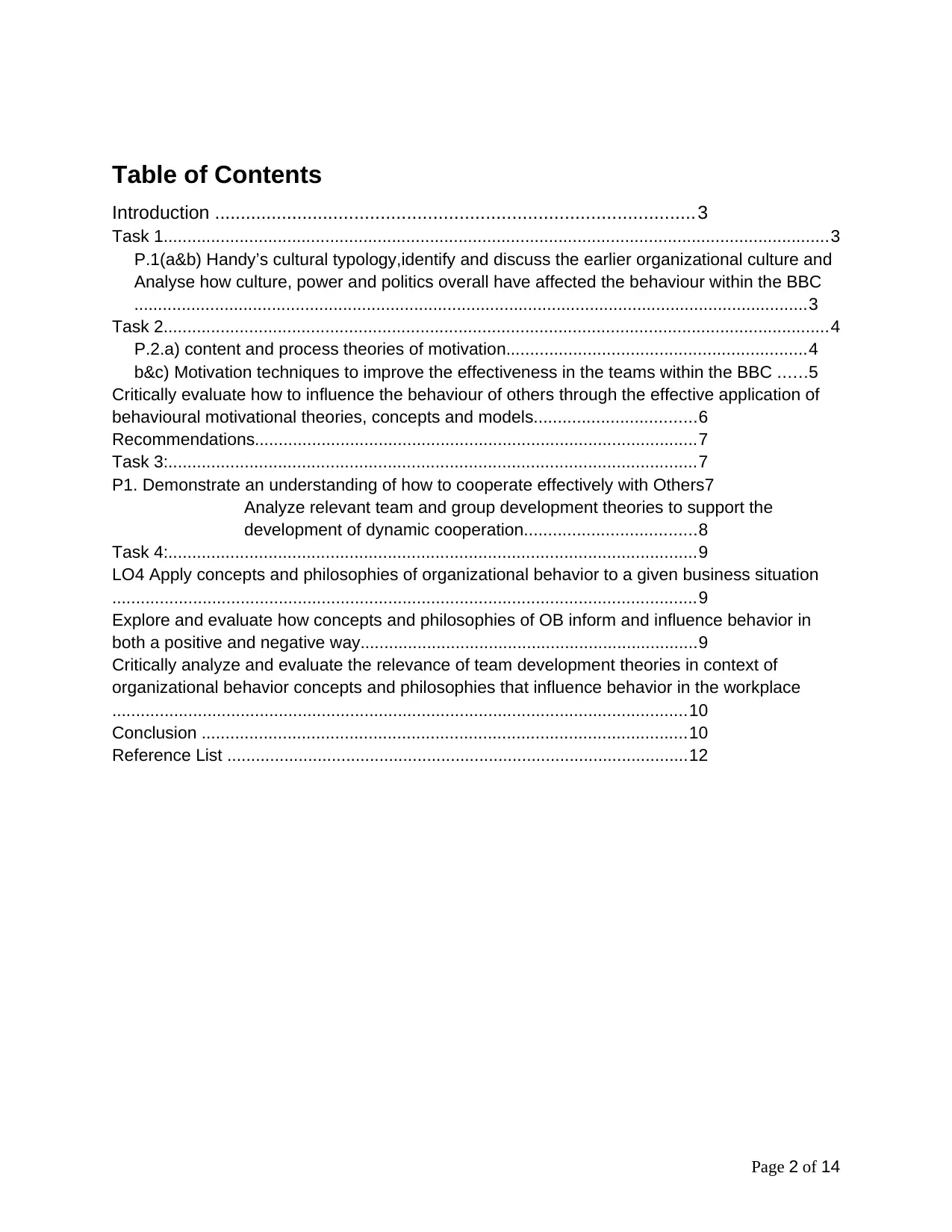
Table of Contents
Introduction ............................................................................................3
Task 1............................................................................................................................................3
P.1(a&b) Handy’s cultural typology,identify and discuss the earlier organizational culture and
Analyse how culture, power and politics overall have affected the behaviour within the BBC
..............................................................................................................................................3
Task 2............................................................................................................................................4
P.2.a) content and process theories of motivation...............................................................4
b&c) Motivation techniques to improve the effectiveness in the teams within the BBC ......5
Critically evaluate how to influence the behaviour of others through the effective application of
behavioural motivational theories, concepts and models..................................6
Recommendations.............................................................................................7
Task 3:...............................................................................................................7
P1. Demonstrate an understanding of how to cooperate effectively with Others7
Analyze relevant team and group development theories to support the
development of dynamic cooperation....................................8
Task 4:...............................................................................................................9
LO4 Apply concepts and philosophies of organizational behavior to a given business situation
...........................................................................................................................9
Explore and evaluate how concepts and philosophies of OB inform and influence behavior in
both a positive and negative way.......................................................................9
Critically analyze and evaluate the relevance of team development theories in context of
organizational behavior concepts and philosophies that influence behavior in the workplace
.........................................................................................................................10
Conclusion ......................................................................................................10
Reference List .................................................................................................12
Page 2 of 14
Introduction ............................................................................................3
Task 1............................................................................................................................................3
P.1(a&b) Handy’s cultural typology,identify and discuss the earlier organizational culture and
Analyse how culture, power and politics overall have affected the behaviour within the BBC
..............................................................................................................................................3
Task 2............................................................................................................................................4
P.2.a) content and process theories of motivation...............................................................4
b&c) Motivation techniques to improve the effectiveness in the teams within the BBC ......5
Critically evaluate how to influence the behaviour of others through the effective application of
behavioural motivational theories, concepts and models..................................6
Recommendations.............................................................................................7
Task 3:...............................................................................................................7
P1. Demonstrate an understanding of how to cooperate effectively with Others7
Analyze relevant team and group development theories to support the
development of dynamic cooperation....................................8
Task 4:...............................................................................................................9
LO4 Apply concepts and philosophies of organizational behavior to a given business situation
...........................................................................................................................9
Explore and evaluate how concepts and philosophies of OB inform and influence behavior in
both a positive and negative way.......................................................................9
Critically analyze and evaluate the relevance of team development theories in context of
organizational behavior concepts and philosophies that influence behavior in the workplace
.........................................................................................................................10
Conclusion ......................................................................................................10
Reference List .................................................................................................12
Page 2 of 14
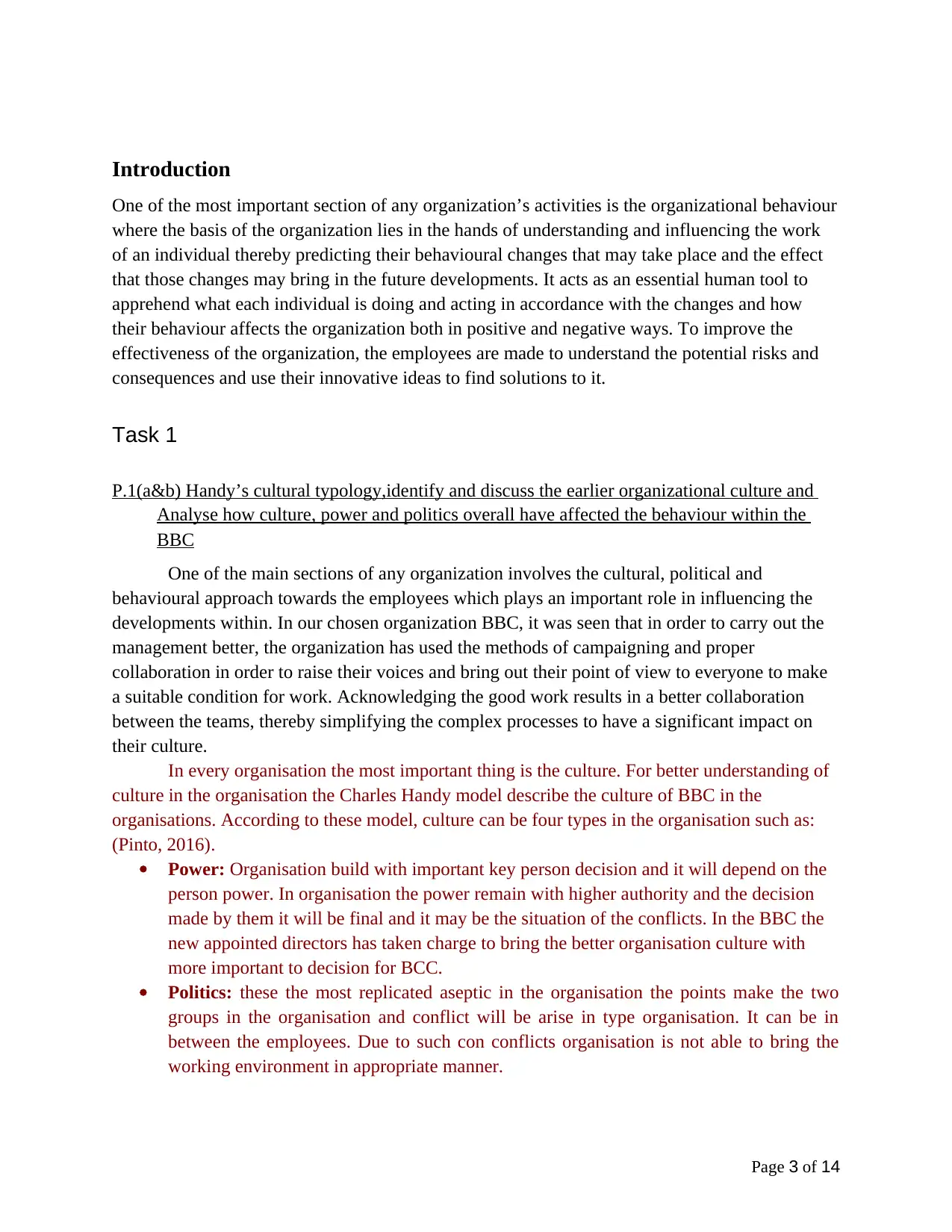
Introduction
One of the most important section of any organization’s activities is the organizational behaviour
where the basis of the organization lies in the hands of understanding and influencing the work
of an individual thereby predicting their behavioural changes that may take place and the effect
that those changes may bring in the future developments. It acts as an essential human tool to
apprehend what each individual is doing and acting in accordance with the changes and how
their behaviour affects the organization both in positive and negative ways. To improve the
effectiveness of the organization, the employees are made to understand the potential risks and
consequences and use their innovative ideas to find solutions to it.
Task 1
P.1(a&b) Handy’s cultural typology,identify and discuss the earlier organizational culture and
Analyse how culture, power and politics overall have affected the behaviour within the
BBC
One of the main sections of any organization involves the cultural, political and
behavioural approach towards the employees which plays an important role in influencing the
developments within. In our chosen organization BBC, it was seen that in order to carry out the
management better, the organization has used the methods of campaigning and proper
collaboration in order to raise their voices and bring out their point of view to everyone to make
a suitable condition for work. Acknowledging the good work results in a better collaboration
between the teams, thereby simplifying the complex processes to have a significant impact on
their culture.
In every organisation the most important thing is the culture. For better understanding of
culture in the organisation the Charles Handy model describe the culture of BBC in the
organisations. According to these model, culture can be four types in the organisation such as:
(Pinto, 2016).
Power: Organisation build with important key person decision and it will depend on the
person power. In organisation the power remain with higher authority and the decision
made by them it will be final and it may be the situation of the conflicts. In the BBC the
new appointed directors has taken charge to bring the better organisation culture with
more important to decision for BCC.
Politics: these the most replicated aseptic in the organisation the points make the two
groups in the organisation and conflict will be arise in type organisation. It can be in
between the employees. Due to such con conflicts organisation is not able to bring the
working environment in appropriate manner.
Page 3 of 14
One of the most important section of any organization’s activities is the organizational behaviour
where the basis of the organization lies in the hands of understanding and influencing the work
of an individual thereby predicting their behavioural changes that may take place and the effect
that those changes may bring in the future developments. It acts as an essential human tool to
apprehend what each individual is doing and acting in accordance with the changes and how
their behaviour affects the organization both in positive and negative ways. To improve the
effectiveness of the organization, the employees are made to understand the potential risks and
consequences and use their innovative ideas to find solutions to it.
Task 1
P.1(a&b) Handy’s cultural typology,identify and discuss the earlier organizational culture and
Analyse how culture, power and politics overall have affected the behaviour within the
BBC
One of the main sections of any organization involves the cultural, political and
behavioural approach towards the employees which plays an important role in influencing the
developments within. In our chosen organization BBC, it was seen that in order to carry out the
management better, the organization has used the methods of campaigning and proper
collaboration in order to raise their voices and bring out their point of view to everyone to make
a suitable condition for work. Acknowledging the good work results in a better collaboration
between the teams, thereby simplifying the complex processes to have a significant impact on
their culture.
In every organisation the most important thing is the culture. For better understanding of
culture in the organisation the Charles Handy model describe the culture of BBC in the
organisations. According to these model, culture can be four types in the organisation such as:
(Pinto, 2016).
Power: Organisation build with important key person decision and it will depend on the
person power. In organisation the power remain with higher authority and the decision
made by them it will be final and it may be the situation of the conflicts. In the BBC the
new appointed directors has taken charge to bring the better organisation culture with
more important to decision for BCC.
Politics: these the most replicated aseptic in the organisation the points make the two
groups in the organisation and conflict will be arise in type organisation. It can be in
between the employees. Due to such con conflicts organisation is not able to bring the
working environment in appropriate manner.
Page 3 of 14
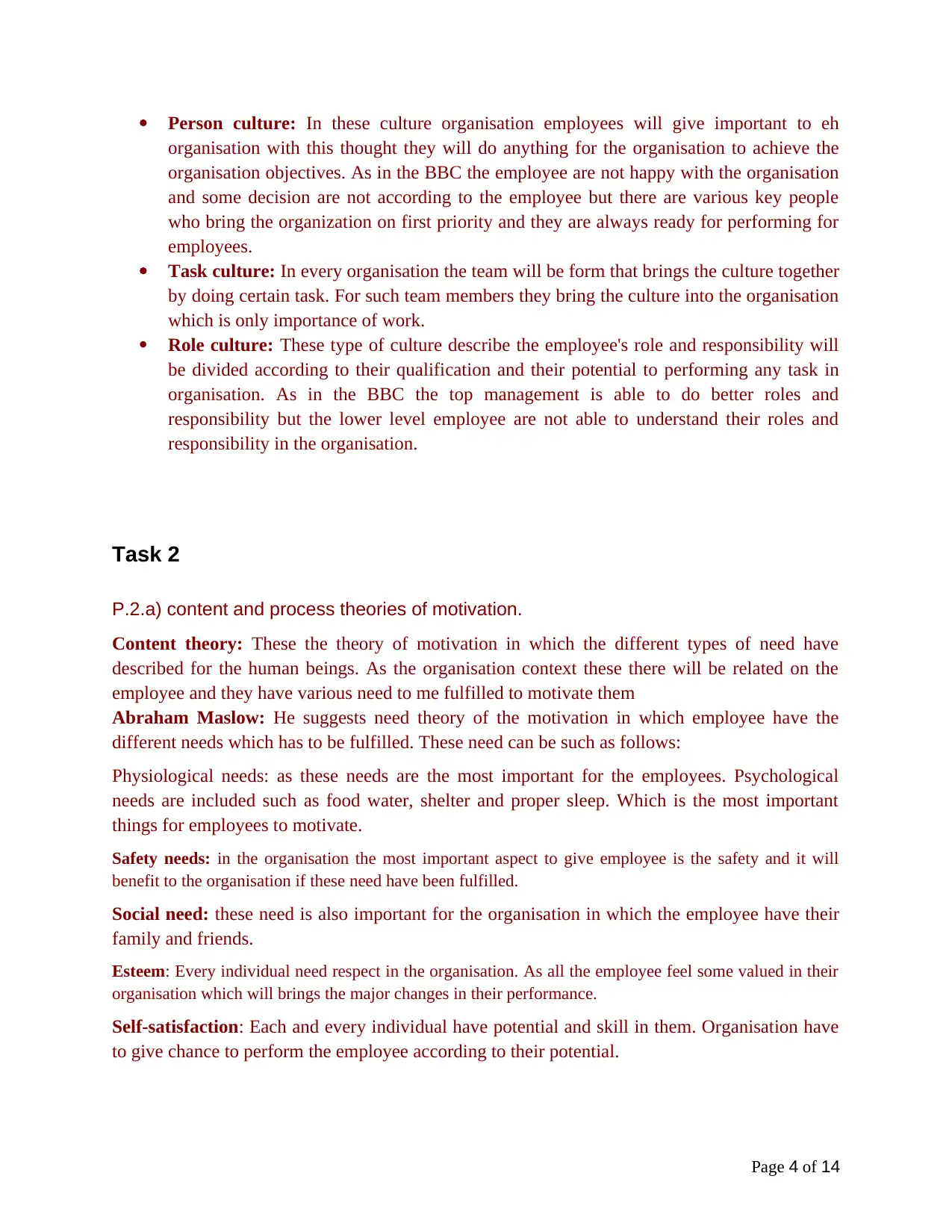
Person culture: In these culture organisation employees will give important to eh
organisation with this thought they will do anything for the organisation to achieve the
organisation objectives. As in the BBC the employee are not happy with the organisation
and some decision are not according to the employee but there are various key people
who bring the organization on first priority and they are always ready for performing for
employees.
Task culture: In every organisation the team will be form that brings the culture together
by doing certain task. For such team members they bring the culture into the organisation
which is only importance of work.
Role culture: These type of culture describe the employee's role and responsibility will
be divided according to their qualification and their potential to performing any task in
organisation. As in the BBC the top management is able to do better roles and
responsibility but the lower level employee are not able to understand their roles and
responsibility in the organisation.
Task 2
P.2.a) content and process theories of motivation.
Content theory: These the theory of motivation in which the different types of need have
described for the human beings. As the organisation context these there will be related on the
employee and they have various need to me fulfilled to motivate them
Abraham Maslow: He suggests need theory of the motivation in which employee have the
different needs which has to be fulfilled. These need can be such as follows:
Physiological needs: as these needs are the most important for the employees. Psychological
needs are included such as food water, shelter and proper sleep. Which is the most important
things for employees to motivate.
Safety needs: in the organisation the most important aspect to give employee is the safety and it will
benefit to the organisation if these need have been fulfilled.
Social need: these need is also important for the organisation in which the employee have their
family and friends.
Esteem: Every individual need respect in the organisation. As all the employee feel some valued in their
organisation which will brings the major changes in their performance.
Self-satisfaction: Each and every individual have potential and skill in them. Organisation have
to give chance to perform the employee according to their potential.
Page 4 of 14
organisation with this thought they will do anything for the organisation to achieve the
organisation objectives. As in the BBC the employee are not happy with the organisation
and some decision are not according to the employee but there are various key people
who bring the organization on first priority and they are always ready for performing for
employees.
Task culture: In every organisation the team will be form that brings the culture together
by doing certain task. For such team members they bring the culture into the organisation
which is only importance of work.
Role culture: These type of culture describe the employee's role and responsibility will
be divided according to their qualification and their potential to performing any task in
organisation. As in the BBC the top management is able to do better roles and
responsibility but the lower level employee are not able to understand their roles and
responsibility in the organisation.
Task 2
P.2.a) content and process theories of motivation.
Content theory: These the theory of motivation in which the different types of need have
described for the human beings. As the organisation context these there will be related on the
employee and they have various need to me fulfilled to motivate them
Abraham Maslow: He suggests need theory of the motivation in which employee have the
different needs which has to be fulfilled. These need can be such as follows:
Physiological needs: as these needs are the most important for the employees. Psychological
needs are included such as food water, shelter and proper sleep. Which is the most important
things for employees to motivate.
Safety needs: in the organisation the most important aspect to give employee is the safety and it will
benefit to the organisation if these need have been fulfilled.
Social need: these need is also important for the organisation in which the employee have their
family and friends.
Esteem: Every individual need respect in the organisation. As all the employee feel some valued in their
organisation which will brings the major changes in their performance.
Self-satisfaction: Each and every individual have potential and skill in them. Organisation have
to give chance to perform the employee according to their potential.
Page 4 of 14
Secure Best Marks with AI Grader
Need help grading? Try our AI Grader for instant feedback on your assignments.
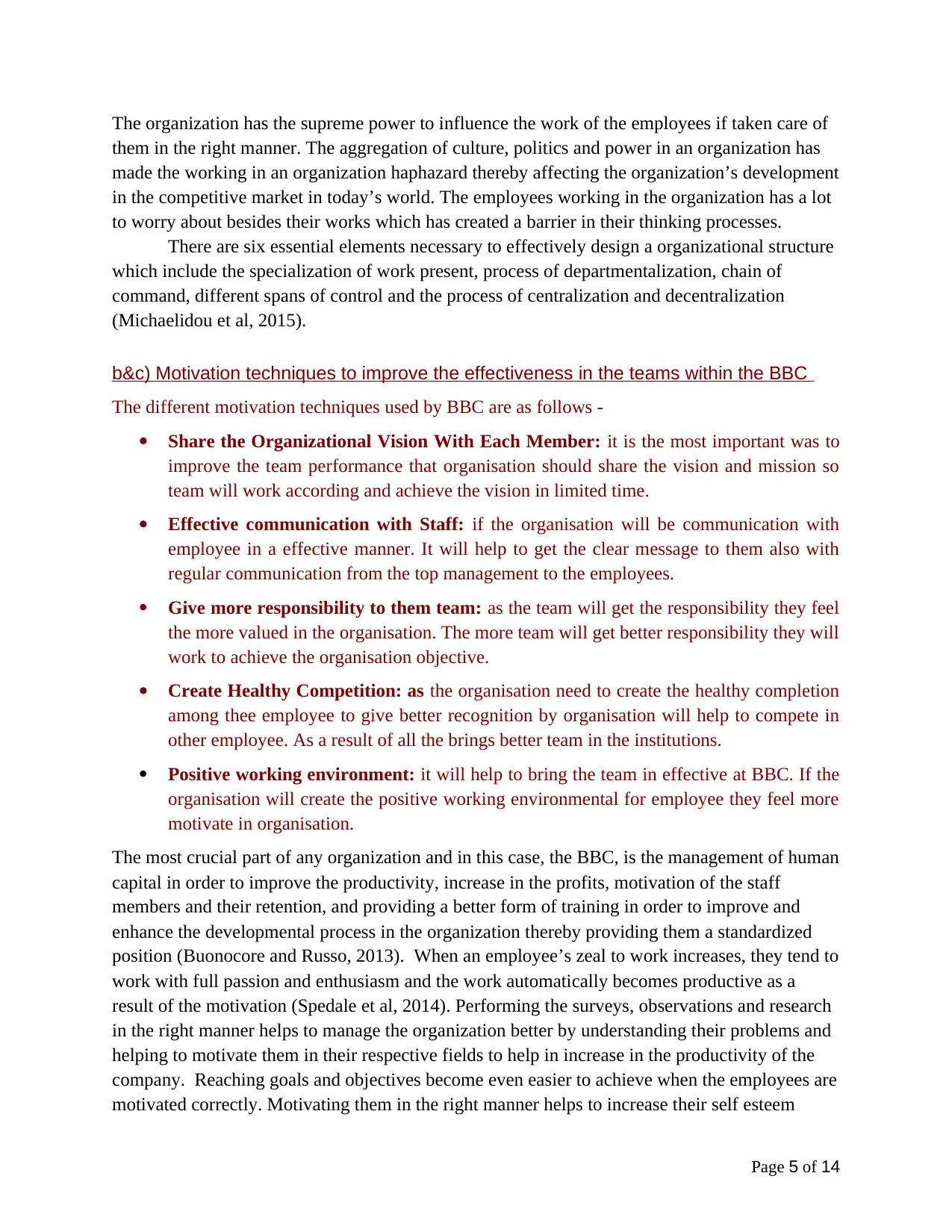
The organization has the supreme power to influence the work of the employees if taken care of
them in the right manner. The aggregation of culture, politics and power in an organization has
made the working in an organization haphazard thereby affecting the organization’s development
in the competitive market in today’s world. The employees working in the organization has a lot
to worry about besides their works which has created a barrier in their thinking processes.
There are six essential elements necessary to effectively design a organizational structure
which include the specialization of work present, process of departmentalization, chain of
command, different spans of control and the process of centralization and decentralization
(Michaelidou et al, 2015).
b&c) Motivation techniques to improve the effectiveness in the teams within the BBC
The different motivation techniques used by BBC are as follows -
Share the Organizational Vision With Each Member: it is the most important was to
improve the team performance that organisation should share the vision and mission so
team will work according and achieve the vision in limited time.
Effective communication with Staff: if the organisation will be communication with
employee in a effective manner. It will help to get the clear message to them also with
regular communication from the top management to the employees.
Give more responsibility to them team: as the team will get the responsibility they feel
the more valued in the organisation. The more team will get better responsibility they will
work to achieve the organisation objective.
Create Healthy Competition: as the organisation need to create the healthy completion
among thee employee to give better recognition by organisation will help to compete in
other employee. As a result of all the brings better team in the institutions.
Positive working environment: it will help to bring the team in effective at BBC. If the
organisation will create the positive working environmental for employee they feel more
motivate in organisation.
The most crucial part of any organization and in this case, the BBC, is the management of human
capital in order to improve the productivity, increase in the profits, motivation of the staff
members and their retention, and providing a better form of training in order to improve and
enhance the developmental process in the organization thereby providing them a standardized
position (Buonocore and Russo, 2013). When an employee’s zeal to work increases, they tend to
work with full passion and enthusiasm and the work automatically becomes productive as a
result of the motivation (Spedale et al, 2014). Performing the surveys, observations and research
in the right manner helps to manage the organization better by understanding their problems and
helping to motivate them in their respective fields to help in increase in the productivity of the
company. Reaching goals and objectives become even easier to achieve when the employees are
motivated correctly. Motivating them in the right manner helps to increase their self esteem
Page 5 of 14
them in the right manner. The aggregation of culture, politics and power in an organization has
made the working in an organization haphazard thereby affecting the organization’s development
in the competitive market in today’s world. The employees working in the organization has a lot
to worry about besides their works which has created a barrier in their thinking processes.
There are six essential elements necessary to effectively design a organizational structure
which include the specialization of work present, process of departmentalization, chain of
command, different spans of control and the process of centralization and decentralization
(Michaelidou et al, 2015).
b&c) Motivation techniques to improve the effectiveness in the teams within the BBC
The different motivation techniques used by BBC are as follows -
Share the Organizational Vision With Each Member: it is the most important was to
improve the team performance that organisation should share the vision and mission so
team will work according and achieve the vision in limited time.
Effective communication with Staff: if the organisation will be communication with
employee in a effective manner. It will help to get the clear message to them also with
regular communication from the top management to the employees.
Give more responsibility to them team: as the team will get the responsibility they feel
the more valued in the organisation. The more team will get better responsibility they will
work to achieve the organisation objective.
Create Healthy Competition: as the organisation need to create the healthy completion
among thee employee to give better recognition by organisation will help to compete in
other employee. As a result of all the brings better team in the institutions.
Positive working environment: it will help to bring the team in effective at BBC. If the
organisation will create the positive working environmental for employee they feel more
motivate in organisation.
The most crucial part of any organization and in this case, the BBC, is the management of human
capital in order to improve the productivity, increase in the profits, motivation of the staff
members and their retention, and providing a better form of training in order to improve and
enhance the developmental process in the organization thereby providing them a standardized
position (Buonocore and Russo, 2013). When an employee’s zeal to work increases, they tend to
work with full passion and enthusiasm and the work automatically becomes productive as a
result of the motivation (Spedale et al, 2014). Performing the surveys, observations and research
in the right manner helps to manage the organization better by understanding their problems and
helping to motivate them in their respective fields to help in increase in the productivity of the
company. Reaching goals and objectives become even easier to achieve when the employees are
motivated correctly. Motivating them in the right manner helps to increase their self esteem
Page 5 of 14
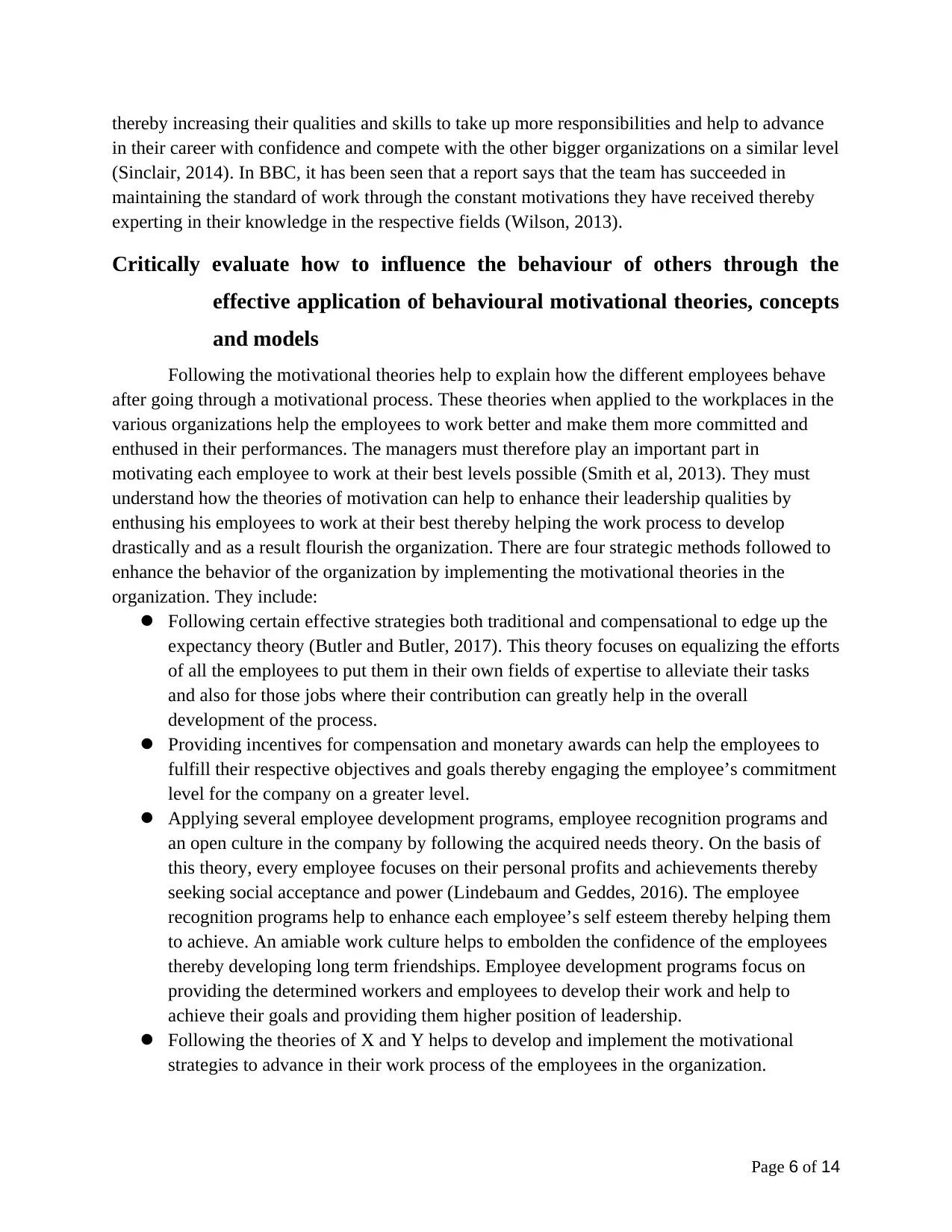
thereby increasing their qualities and skills to take up more responsibilities and help to advance
in their career with confidence and compete with the other bigger organizations on a similar level
(Sinclair, 2014). In BBC, it has been seen that a report says that the team has succeeded in
maintaining the standard of work through the constant motivations they have received thereby
experting in their knowledge in the respective fields (Wilson, 2013).
Critically evaluate how to influence the behaviour of others through the
effective application of behavioural motivational theories, concepts
and models
Following the motivational theories help to explain how the different employees behave
after going through a motivational process. These theories when applied to the workplaces in the
various organizations help the employees to work better and make them more committed and
enthused in their performances. The managers must therefore play an important part in
motivating each employee to work at their best levels possible (Smith et al, 2013). They must
understand how the theories of motivation can help to enhance their leadership qualities by
enthusing his employees to work at their best thereby helping the work process to develop
drastically and as a result flourish the organization. There are four strategic methods followed to
enhance the behavior of the organization by implementing the motivational theories in the
organization. They include:
Following certain effective strategies both traditional and compensational to edge up the
expectancy theory (Butler and Butler, 2017). This theory focuses on equalizing the efforts
of all the employees to put them in their own fields of expertise to alleviate their tasks
and also for those jobs where their contribution can greatly help in the overall
development of the process.
Providing incentives for compensation and monetary awards can help the employees to
fulfill their respective objectives and goals thereby engaging the employee’s commitment
level for the company on a greater level.
Applying several employee development programs, employee recognition programs and
an open culture in the company by following the acquired needs theory. On the basis of
this theory, every employee focuses on their personal profits and achievements thereby
seeking social acceptance and power (Lindebaum and Geddes, 2016). The employee
recognition programs help to enhance each employee’s self esteem thereby helping them
to achieve. An amiable work culture helps to embolden the confidence of the employees
thereby developing long term friendships. Employee development programs focus on
providing the determined workers and employees to develop their work and help to
achieve their goals and providing them higher position of leadership.
Following the theories of X and Y helps to develop and implement the motivational
strategies to advance in their work process of the employees in the organization.
Page 6 of 14
in their career with confidence and compete with the other bigger organizations on a similar level
(Sinclair, 2014). In BBC, it has been seen that a report says that the team has succeeded in
maintaining the standard of work through the constant motivations they have received thereby
experting in their knowledge in the respective fields (Wilson, 2013).
Critically evaluate how to influence the behaviour of others through the
effective application of behavioural motivational theories, concepts
and models
Following the motivational theories help to explain how the different employees behave
after going through a motivational process. These theories when applied to the workplaces in the
various organizations help the employees to work better and make them more committed and
enthused in their performances. The managers must therefore play an important part in
motivating each employee to work at their best levels possible (Smith et al, 2013). They must
understand how the theories of motivation can help to enhance their leadership qualities by
enthusing his employees to work at their best thereby helping the work process to develop
drastically and as a result flourish the organization. There are four strategic methods followed to
enhance the behavior of the organization by implementing the motivational theories in the
organization. They include:
Following certain effective strategies both traditional and compensational to edge up the
expectancy theory (Butler and Butler, 2017). This theory focuses on equalizing the efforts
of all the employees to put them in their own fields of expertise to alleviate their tasks
and also for those jobs where their contribution can greatly help in the overall
development of the process.
Providing incentives for compensation and monetary awards can help the employees to
fulfill their respective objectives and goals thereby engaging the employee’s commitment
level for the company on a greater level.
Applying several employee development programs, employee recognition programs and
an open culture in the company by following the acquired needs theory. On the basis of
this theory, every employee focuses on their personal profits and achievements thereby
seeking social acceptance and power (Lindebaum and Geddes, 2016). The employee
recognition programs help to enhance each employee’s self esteem thereby helping them
to achieve. An amiable work culture helps to embolden the confidence of the employees
thereby developing long term friendships. Employee development programs focus on
providing the determined workers and employees to develop their work and help to
achieve their goals and providing them higher position of leadership.
Following the theories of X and Y helps to develop and implement the motivational
strategies to advance in their work process of the employees in the organization.
Page 6 of 14
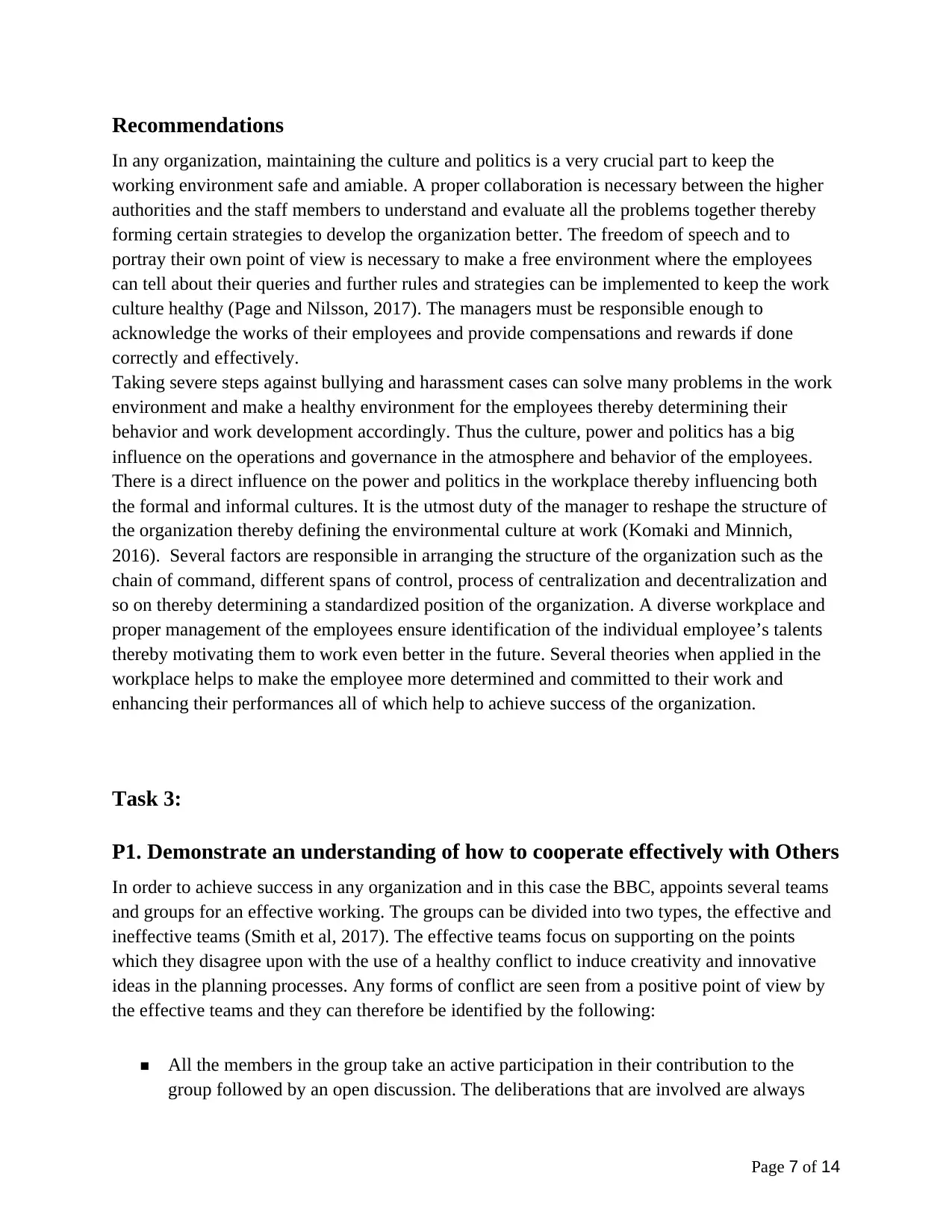
Recommendations
In any organization, maintaining the culture and politics is a very crucial part to keep the
working environment safe and amiable. A proper collaboration is necessary between the higher
authorities and the staff members to understand and evaluate all the problems together thereby
forming certain strategies to develop the organization better. The freedom of speech and to
portray their own point of view is necessary to make a free environment where the employees
can tell about their queries and further rules and strategies can be implemented to keep the work
culture healthy (Page and Nilsson, 2017). The managers must be responsible enough to
acknowledge the works of their employees and provide compensations and rewards if done
correctly and effectively.
Taking severe steps against bullying and harassment cases can solve many problems in the work
environment and make a healthy environment for the employees thereby determining their
behavior and work development accordingly. Thus the culture, power and politics has a big
influence on the operations and governance in the atmosphere and behavior of the employees.
There is a direct influence on the power and politics in the workplace thereby influencing both
the formal and informal cultures. It is the utmost duty of the manager to reshape the structure of
the organization thereby defining the environmental culture at work (Komaki and Minnich,
2016). Several factors are responsible in arranging the structure of the organization such as the
chain of command, different spans of control, process of centralization and decentralization and
so on thereby determining a standardized position of the organization. A diverse workplace and
proper management of the employees ensure identification of the individual employee’s talents
thereby motivating them to work even better in the future. Several theories when applied in the
workplace helps to make the employee more determined and committed to their work and
enhancing their performances all of which help to achieve success of the organization.
Task 3:
P1. Demonstrate an understanding of how to cooperate effectively with Others
In order to achieve success in any organization and in this case the BBC, appoints several teams
and groups for an effective working. The groups can be divided into two types, the effective and
ineffective teams (Smith et al, 2017). The effective teams focus on supporting on the points
which they disagree upon with the use of a healthy conflict to induce creativity and innovative
ideas in the planning processes. Any forms of conflict are seen from a positive point of view by
the effective teams and they can therefore be identified by the following:
■ All the members in the group take an active participation in their contribution to the
group followed by an open discussion. The deliberations that are involved are always
Page 7 of 14
In any organization, maintaining the culture and politics is a very crucial part to keep the
working environment safe and amiable. A proper collaboration is necessary between the higher
authorities and the staff members to understand and evaluate all the problems together thereby
forming certain strategies to develop the organization better. The freedom of speech and to
portray their own point of view is necessary to make a free environment where the employees
can tell about their queries and further rules and strategies can be implemented to keep the work
culture healthy (Page and Nilsson, 2017). The managers must be responsible enough to
acknowledge the works of their employees and provide compensations and rewards if done
correctly and effectively.
Taking severe steps against bullying and harassment cases can solve many problems in the work
environment and make a healthy environment for the employees thereby determining their
behavior and work development accordingly. Thus the culture, power and politics has a big
influence on the operations and governance in the atmosphere and behavior of the employees.
There is a direct influence on the power and politics in the workplace thereby influencing both
the formal and informal cultures. It is the utmost duty of the manager to reshape the structure of
the organization thereby defining the environmental culture at work (Komaki and Minnich,
2016). Several factors are responsible in arranging the structure of the organization such as the
chain of command, different spans of control, process of centralization and decentralization and
so on thereby determining a standardized position of the organization. A diverse workplace and
proper management of the employees ensure identification of the individual employee’s talents
thereby motivating them to work even better in the future. Several theories when applied in the
workplace helps to make the employee more determined and committed to their work and
enhancing their performances all of which help to achieve success of the organization.
Task 3:
P1. Demonstrate an understanding of how to cooperate effectively with Others
In order to achieve success in any organization and in this case the BBC, appoints several teams
and groups for an effective working. The groups can be divided into two types, the effective and
ineffective teams (Smith et al, 2017). The effective teams focus on supporting on the points
which they disagree upon with the use of a healthy conflict to induce creativity and innovative
ideas in the planning processes. Any forms of conflict are seen from a positive point of view by
the effective teams and they can therefore be identified by the following:
■ All the members in the group take an active participation in their contribution to the
group followed by an open discussion. The deliberations that are involved are always
Page 7 of 14
Paraphrase This Document
Need a fresh take? Get an instant paraphrase of this document with our AI Paraphraser
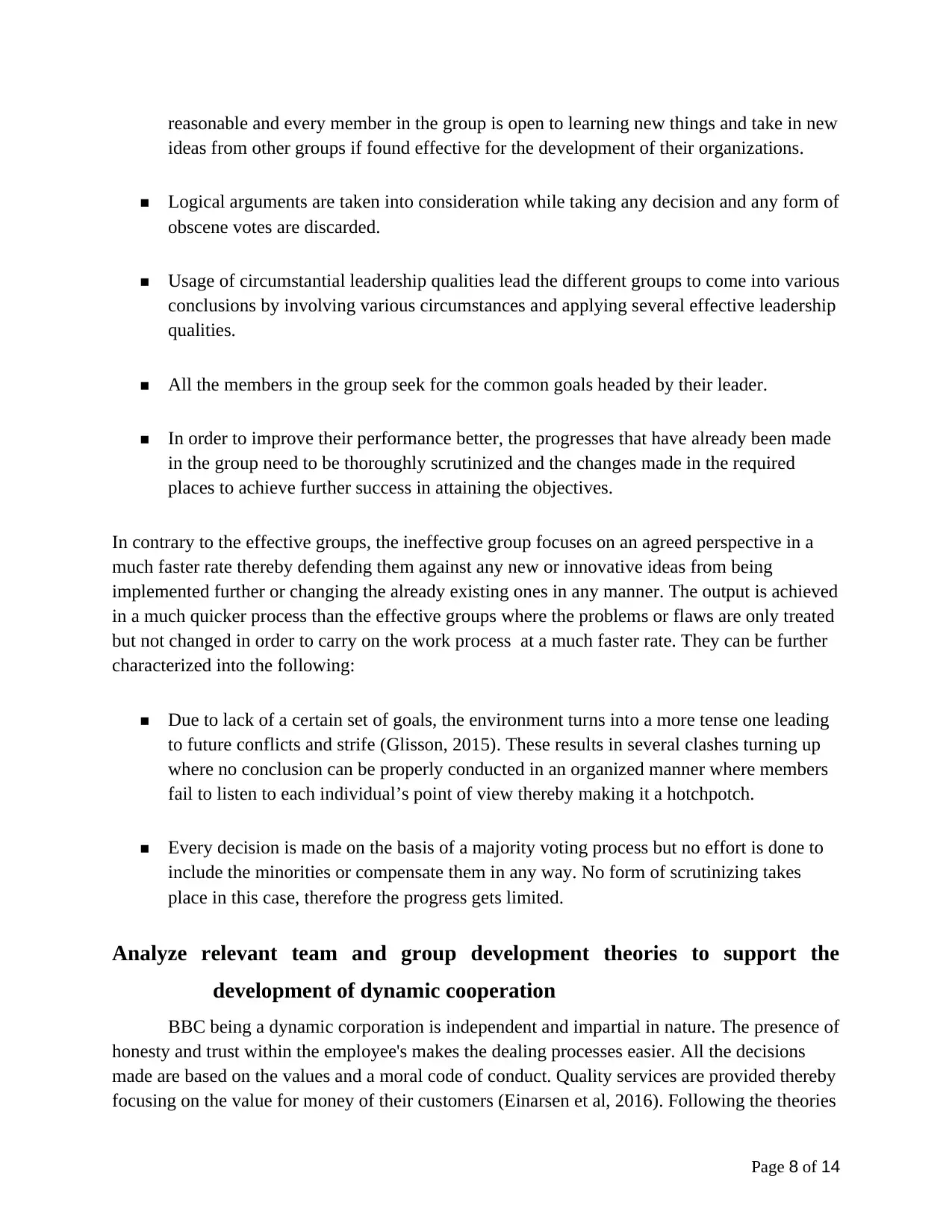
reasonable and every member in the group is open to learning new things and take in new
ideas from other groups if found effective for the development of their organizations.
■ Logical arguments are taken into consideration while taking any decision and any form of
obscene votes are discarded.
■ Usage of circumstantial leadership qualities lead the different groups to come into various
conclusions by involving various circumstances and applying several effective leadership
qualities.
■ All the members in the group seek for the common goals headed by their leader.
■ In order to improve their performance better, the progresses that have already been made
in the group need to be thoroughly scrutinized and the changes made in the required
places to achieve further success in attaining the objectives.
In contrary to the effective groups, the ineffective group focuses on an agreed perspective in a
much faster rate thereby defending them against any new or innovative ideas from being
implemented further or changing the already existing ones in any manner. The output is achieved
in a much quicker process than the effective groups where the problems or flaws are only treated
but not changed in order to carry on the work process at a much faster rate. They can be further
characterized into the following:
■ Due to lack of a certain set of goals, the environment turns into a more tense one leading
to future conflicts and strife (Glisson, 2015). These results in several clashes turning up
where no conclusion can be properly conducted in an organized manner where members
fail to listen to each individual’s point of view thereby making it a hotchpotch.
■ Every decision is made on the basis of a majority voting process but no effort is done to
include the minorities or compensate them in any way. No form of scrutinizing takes
place in this case, therefore the progress gets limited.
Analyze relevant team and group development theories to support the
development of dynamic cooperation
BBC being a dynamic corporation is independent and impartial in nature. The presence of
honesty and trust within the employee's makes the dealing processes easier. All the decisions
made are based on the values and a moral code of conduct. Quality services are provided thereby
focusing on the value for money of their customers (Einarsen et al, 2016). Following the theories
Page 8 of 14
ideas from other groups if found effective for the development of their organizations.
■ Logical arguments are taken into consideration while taking any decision and any form of
obscene votes are discarded.
■ Usage of circumstantial leadership qualities lead the different groups to come into various
conclusions by involving various circumstances and applying several effective leadership
qualities.
■ All the members in the group seek for the common goals headed by their leader.
■ In order to improve their performance better, the progresses that have already been made
in the group need to be thoroughly scrutinized and the changes made in the required
places to achieve further success in attaining the objectives.
In contrary to the effective groups, the ineffective group focuses on an agreed perspective in a
much faster rate thereby defending them against any new or innovative ideas from being
implemented further or changing the already existing ones in any manner. The output is achieved
in a much quicker process than the effective groups where the problems or flaws are only treated
but not changed in order to carry on the work process at a much faster rate. They can be further
characterized into the following:
■ Due to lack of a certain set of goals, the environment turns into a more tense one leading
to future conflicts and strife (Glisson, 2015). These results in several clashes turning up
where no conclusion can be properly conducted in an organized manner where members
fail to listen to each individual’s point of view thereby making it a hotchpotch.
■ Every decision is made on the basis of a majority voting process but no effort is done to
include the minorities or compensate them in any way. No form of scrutinizing takes
place in this case, therefore the progress gets limited.
Analyze relevant team and group development theories to support the
development of dynamic cooperation
BBC being a dynamic corporation is independent and impartial in nature. The presence of
honesty and trust within the employee's makes the dealing processes easier. All the decisions
made are based on the values and a moral code of conduct. Quality services are provided thereby
focusing on the value for money of their customers (Einarsen et al, 2016). Following the theories
Page 8 of 14

for motivation and group development has therefore enhanced the working of the employees by
ridding all the evil aspects in the environment and providing a healthy environment for work.
They are now more enthused to use their innovative ideas and styles of creativity to get hold of
the new technology and use it to scrutinize and develop their works better. Several groups and
teams are formed and each individual’s viewpoint and opinions are given due consideration. This
results in developing new opportunities to train and develop the roles of the individuals thereby
placing them in their own fields of expertise. Respect for all and safeguarding each member’s
rights are given due importance (Pettinger, 2013). The team development can be therefore be
divided into five stages for an effective functioning and delivering of the work process. They
include Forming, storming, norming, performing and adjourning all of which if followed
correctly helps to develop the work in the organization better and more effectively.
Task 4:
LO4 Apply concepts and philosophies of organizational behavior to a given
business situation
The organizational behavior of BBC is complementing dependent on the retrieval of the
concept of character and virtue which has great interests in the political parties and other
industries of different aspects. The development of moral values in the individual employees
does a great help in improving the working condition better thereby sustaining their economy
and cherish a healthy democracy (Palmer and Feldman, 2017). The morality and value related to
the decision making process plays a significant role in influencing the decision making processes
in the business. The organization sets up certain goals in order to deter the behavior and
decisions made thereby getting hold of the attention of all. In order to identify the objectives, the
values are therefore given the maximum focus in the conducting of their services. All the ideas
and viewpoints of all the people are taken into consideration and scrutinized and the final result
is made with the objective of fulfilling the company's goals and work for their betterment
(Wegge et al, 2014). Maintaining a proper relation with the public and communicating with them
at all level helps to understand the problems that befall on them and make efforts to develop
them in an effort to enhance the work of their employees and help in the development of the
business in all sectors.
Explore and evaluate how concepts and philosophies of OB inform and
influence behavior in both a positive and negative way
In any organization and in this case the BBC, it has been seen that the co workers and the
employees are not satisfied completely at all times. Several meetings are held in order to
understand and evaluate the problems faced by the employees and discussions made on the basis
of what changes need to be made to keep the employees satisfied. One employee’s bad mood can
Page 9 of 14
ridding all the evil aspects in the environment and providing a healthy environment for work.
They are now more enthused to use their innovative ideas and styles of creativity to get hold of
the new technology and use it to scrutinize and develop their works better. Several groups and
teams are formed and each individual’s viewpoint and opinions are given due consideration. This
results in developing new opportunities to train and develop the roles of the individuals thereby
placing them in their own fields of expertise. Respect for all and safeguarding each member’s
rights are given due importance (Pettinger, 2013). The team development can be therefore be
divided into five stages for an effective functioning and delivering of the work process. They
include Forming, storming, norming, performing and adjourning all of which if followed
correctly helps to develop the work in the organization better and more effectively.
Task 4:
LO4 Apply concepts and philosophies of organizational behavior to a given
business situation
The organizational behavior of BBC is complementing dependent on the retrieval of the
concept of character and virtue which has great interests in the political parties and other
industries of different aspects. The development of moral values in the individual employees
does a great help in improving the working condition better thereby sustaining their economy
and cherish a healthy democracy (Palmer and Feldman, 2017). The morality and value related to
the decision making process plays a significant role in influencing the decision making processes
in the business. The organization sets up certain goals in order to deter the behavior and
decisions made thereby getting hold of the attention of all. In order to identify the objectives, the
values are therefore given the maximum focus in the conducting of their services. All the ideas
and viewpoints of all the people are taken into consideration and scrutinized and the final result
is made with the objective of fulfilling the company's goals and work for their betterment
(Wegge et al, 2014). Maintaining a proper relation with the public and communicating with them
at all level helps to understand the problems that befall on them and make efforts to develop
them in an effort to enhance the work of their employees and help in the development of the
business in all sectors.
Explore and evaluate how concepts and philosophies of OB inform and
influence behavior in both a positive and negative way
In any organization and in this case the BBC, it has been seen that the co workers and the
employees are not satisfied completely at all times. Several meetings are held in order to
understand and evaluate the problems faced by the employees and discussions made on the basis
of what changes need to be made to keep the employees satisfied. One employee’s bad mood can
Page 9 of 14

affect the entire working in the organization and bring out a negative result as a whole. This
negativity in return can affect the company even if any form of good impact takes place. Thus a
constant emotional tumult takes place in the organization and taking care of each member’s
emotional conditions need to be taken care of. A bad mood is so contagious that it can have a
grave effect on the other employees as well. It is therefore the responsibility of the manager to
influence the emotions of the workplace. All the traits and emotions of the employees are given
due consideration thereby influencing the character of each employee and motivating them in all
respect. Therefore emotions are an integral part of every organization and need to be taken care
of carefully.
Critically analyze and evaluate the relevance of team development theories in
context of organizational behavior concepts and philosophies that
influence behavior in the workplace
In the developing of the working in the workplace and improve the behavior of all the
employees, two main teams are made, the effective and ineffective group which focus on certain
issues that are related to understanding all the conflicts and problems that arrive or befall in the
organization and making efforts collectively to eliminate them. Innovative ideas and creativity
are emphasized of each individual’s thereby making a free environment to allow everyone to
speak and think freely. All the flaws of the organization are eliminated and the output received as
a result in properly scrutinized in order to keep all the employees and the customers satisfied at
all times (Butler et al, 2017). Every organization is thus needed to be independent and impartial
by nature thereby implementing honesty and respect among all. The quality of services provided
is also taken due care of. Maintaining a healthy democratic environment in the workplace and
eliminating all sorts of social problems such as bullying and harassments are avoided at all cost.
The moral code of conduct is thus maintained in order to make changes in the work process and
help in developments in the organization (Piszczek, 2017). All of which factors help to stimulate
the economy thereby stimulating a healthy working environment. Maintaining the public
relations and developing the communication process further helps to enhance the work of the
employees thereby helping in the growth in all the sections of the business.
Conclusion
In the given report we can therefore conclude that the organizational behavior is considered to be
one of the important aspects of every organization and BBC has succeeded to a great level in
developing it. The culture and politics in the organization is essential to maintain a healthy
working environment for all thereby safeguarding the rights of all the employees and staffs.
Using the theories explained earlier, it can be seen that the motivational theories have a great
influence in determining the work of all thereby creating a zeal for work for all. In BBC, the
management and campaigning process has done a great deal of development in influencing the
Page 10 of 14
negativity in return can affect the company even if any form of good impact takes place. Thus a
constant emotional tumult takes place in the organization and taking care of each member’s
emotional conditions need to be taken care of. A bad mood is so contagious that it can have a
grave effect on the other employees as well. It is therefore the responsibility of the manager to
influence the emotions of the workplace. All the traits and emotions of the employees are given
due consideration thereby influencing the character of each employee and motivating them in all
respect. Therefore emotions are an integral part of every organization and need to be taken care
of carefully.
Critically analyze and evaluate the relevance of team development theories in
context of organizational behavior concepts and philosophies that
influence behavior in the workplace
In the developing of the working in the workplace and improve the behavior of all the
employees, two main teams are made, the effective and ineffective group which focus on certain
issues that are related to understanding all the conflicts and problems that arrive or befall in the
organization and making efforts collectively to eliminate them. Innovative ideas and creativity
are emphasized of each individual’s thereby making a free environment to allow everyone to
speak and think freely. All the flaws of the organization are eliminated and the output received as
a result in properly scrutinized in order to keep all the employees and the customers satisfied at
all times (Butler et al, 2017). Every organization is thus needed to be independent and impartial
by nature thereby implementing honesty and respect among all. The quality of services provided
is also taken due care of. Maintaining a healthy democratic environment in the workplace and
eliminating all sorts of social problems such as bullying and harassments are avoided at all cost.
The moral code of conduct is thus maintained in order to make changes in the work process and
help in developments in the organization (Piszczek, 2017). All of which factors help to stimulate
the economy thereby stimulating a healthy working environment. Maintaining the public
relations and developing the communication process further helps to enhance the work of the
employees thereby helping in the growth in all the sections of the business.
Conclusion
In the given report we can therefore conclude that the organizational behavior is considered to be
one of the important aspects of every organization and BBC has succeeded to a great level in
developing it. The culture and politics in the organization is essential to maintain a healthy
working environment for all thereby safeguarding the rights of all the employees and staffs.
Using the theories explained earlier, it can be seen that the motivational theories have a great
influence in determining the work of all thereby creating a zeal for work for all. In BBC, the
management and campaigning process has done a great deal of development in influencing the
Page 10 of 14
Secure Best Marks with AI Grader
Need help grading? Try our AI Grader for instant feedback on your assignments.
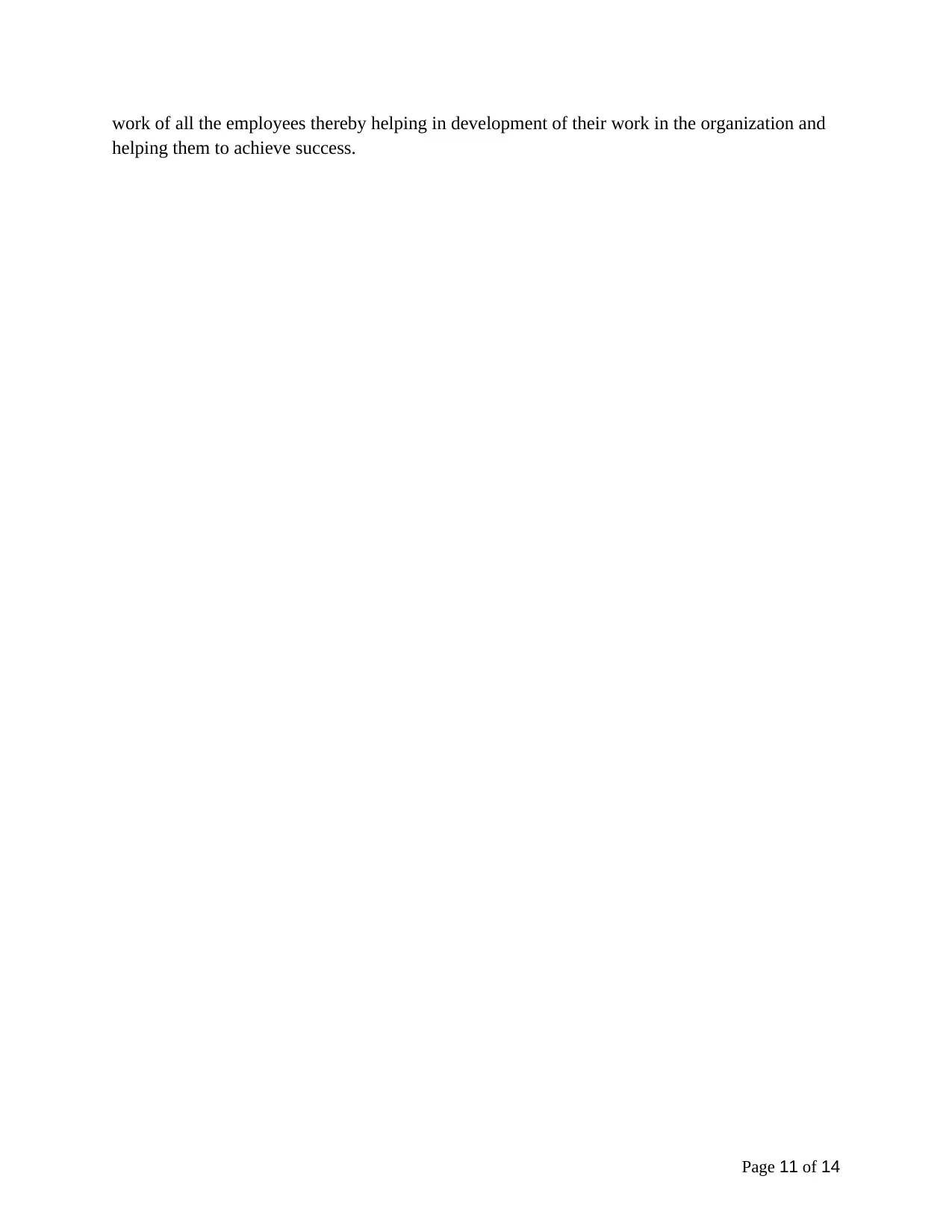
work of all the employees thereby helping in development of their work in the organization and
helping them to achieve success.
Page 11 of 14
helping them to achieve success.
Page 11 of 14
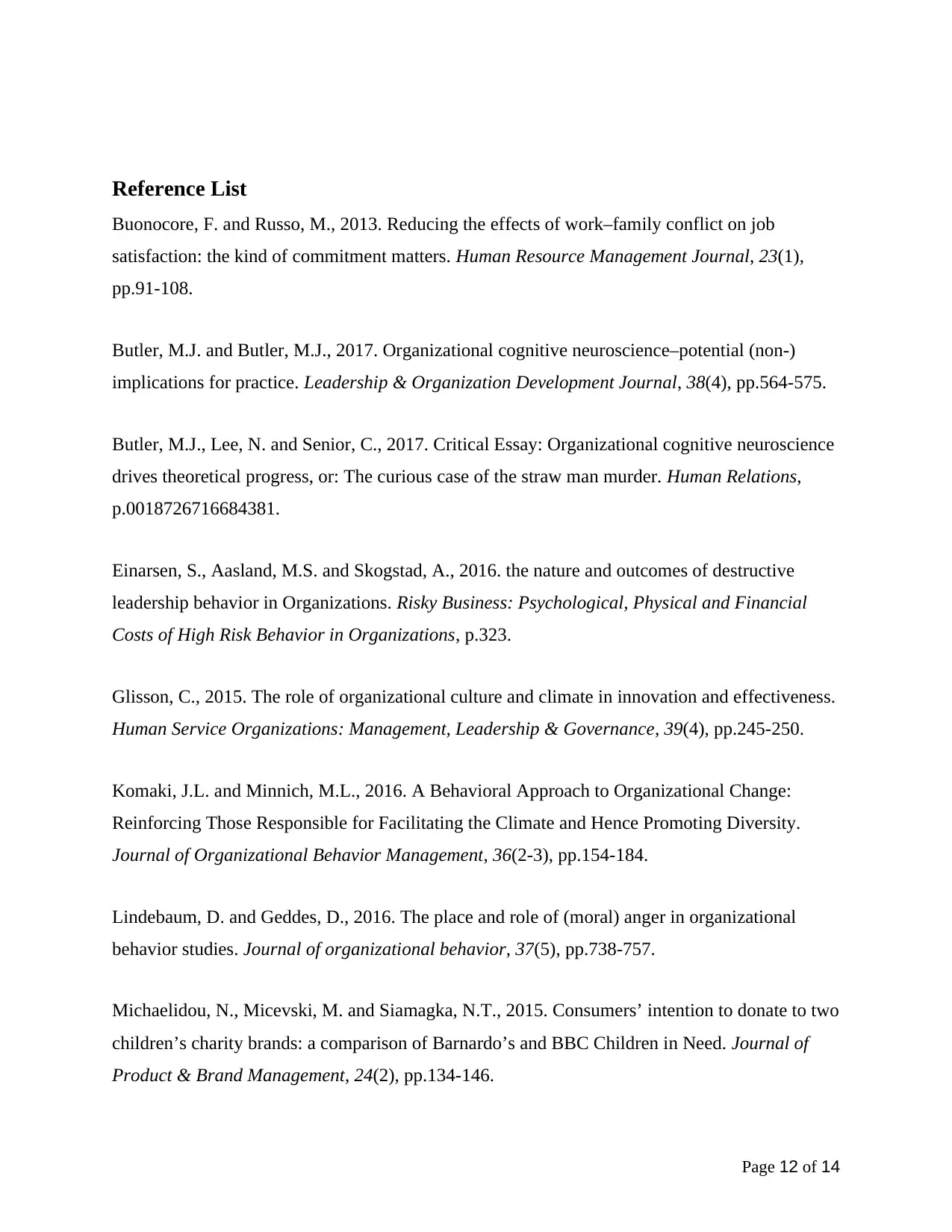
Reference List
Buonocore, F. and Russo, M., 2013. Reducing the effects of work–family conflict on job
satisfaction: the kind of commitment matters. Human Resource Management Journal, 23(1),
pp.91-108.
Butler, M.J. and Butler, M.J., 2017. Organizational cognitive neuroscience–potential (non-)
implications for practice. Leadership & Organization Development Journal, 38(4), pp.564-575.
Butler, M.J., Lee, N. and Senior, C., 2017. Critical Essay: Organizational cognitive neuroscience
drives theoretical progress, or: The curious case of the straw man murder. Human Relations,
p.0018726716684381.
Einarsen, S., Aasland, M.S. and Skogstad, A., 2016. the nature and outcomes of destructive
leadership behavior in Organizations. Risky Business: Psychological, Physical and Financial
Costs of High Risk Behavior in Organizations, p.323.
Glisson, C., 2015. The role of organizational culture and climate in innovation and effectiveness.
Human Service Organizations: Management, Leadership & Governance, 39(4), pp.245-250.
Komaki, J.L. and Minnich, M.L., 2016. A Behavioral Approach to Organizational Change:
Reinforcing Those Responsible for Facilitating the Climate and Hence Promoting Diversity.
Journal of Organizational Behavior Management, 36(2-3), pp.154-184.
Lindebaum, D. and Geddes, D., 2016. The place and role of (moral) anger in organizational
behavior studies. Journal of organizational behavior, 37(5), pp.738-757.
Michaelidou, N., Micevski, M. and Siamagka, N.T., 2015. Consumers’ intention to donate to two
children’s charity brands: a comparison of Barnardo’s and BBC Children in Need. Journal of
Product & Brand Management, 24(2), pp.134-146.
Page 12 of 14
Buonocore, F. and Russo, M., 2013. Reducing the effects of work–family conflict on job
satisfaction: the kind of commitment matters. Human Resource Management Journal, 23(1),
pp.91-108.
Butler, M.J. and Butler, M.J., 2017. Organizational cognitive neuroscience–potential (non-)
implications for practice. Leadership & Organization Development Journal, 38(4), pp.564-575.
Butler, M.J., Lee, N. and Senior, C., 2017. Critical Essay: Organizational cognitive neuroscience
drives theoretical progress, or: The curious case of the straw man murder. Human Relations,
p.0018726716684381.
Einarsen, S., Aasland, M.S. and Skogstad, A., 2016. the nature and outcomes of destructive
leadership behavior in Organizations. Risky Business: Psychological, Physical and Financial
Costs of High Risk Behavior in Organizations, p.323.
Glisson, C., 2015. The role of organizational culture and climate in innovation and effectiveness.
Human Service Organizations: Management, Leadership & Governance, 39(4), pp.245-250.
Komaki, J.L. and Minnich, M.L., 2016. A Behavioral Approach to Organizational Change:
Reinforcing Those Responsible for Facilitating the Climate and Hence Promoting Diversity.
Journal of Organizational Behavior Management, 36(2-3), pp.154-184.
Lindebaum, D. and Geddes, D., 2016. The place and role of (moral) anger in organizational
behavior studies. Journal of organizational behavior, 37(5), pp.738-757.
Michaelidou, N., Micevski, M. and Siamagka, N.T., 2015. Consumers’ intention to donate to two
children’s charity brands: a comparison of Barnardo’s and BBC Children in Need. Journal of
Product & Brand Management, 24(2), pp.134-146.
Page 12 of 14
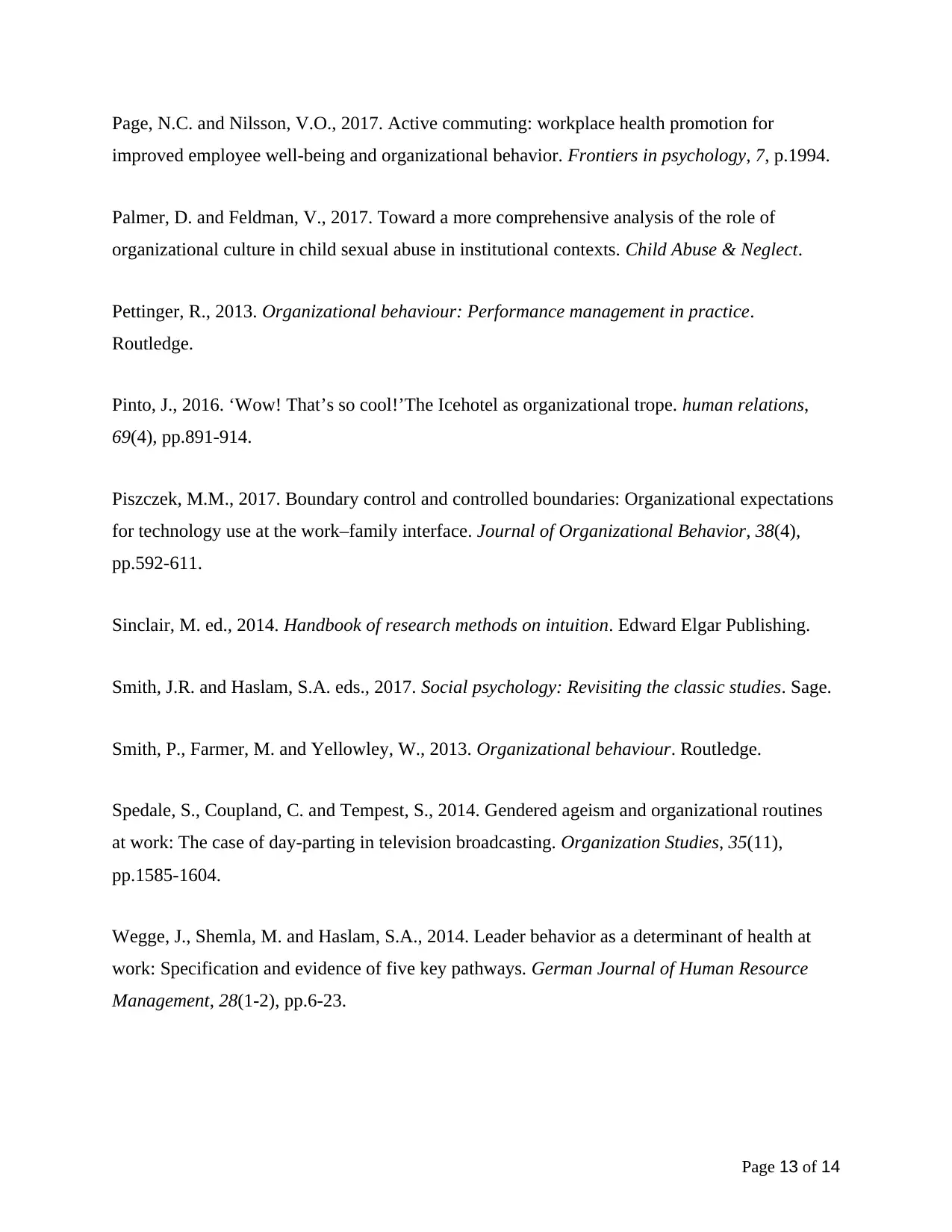
Page, N.C. and Nilsson, V.O., 2017. Active commuting: workplace health promotion for
improved employee well-being and organizational behavior. Frontiers in psychology, 7, p.1994.
Palmer, D. and Feldman, V., 2017. Toward a more comprehensive analysis of the role of
organizational culture in child sexual abuse in institutional contexts. Child Abuse & Neglect.
Pettinger, R., 2013. Organizational behaviour: Performance management in practice.
Routledge.
Pinto, J., 2016. ‘Wow! That’s so cool!’The Icehotel as organizational trope. human relations,
69(4), pp.891-914.
Piszczek, M.M., 2017. Boundary control and controlled boundaries: Organizational expectations
for technology use at the work–family interface. Journal of Organizational Behavior, 38(4),
pp.592-611.
Sinclair, M. ed., 2014. Handbook of research methods on intuition. Edward Elgar Publishing.
Smith, J.R. and Haslam, S.A. eds., 2017. Social psychology: Revisiting the classic studies. Sage.
Smith, P., Farmer, M. and Yellowley, W., 2013. Organizational behaviour. Routledge.
Spedale, S., Coupland, C. and Tempest, S., 2014. Gendered ageism and organizational routines
at work: The case of day-parting in television broadcasting. Organization Studies, 35(11),
pp.1585-1604.
Wegge, J., Shemla, M. and Haslam, S.A., 2014. Leader behavior as a determinant of health at
work: Specification and evidence of five key pathways. German Journal of Human Resource
Management, 28(1-2), pp.6-23.
Page 13 of 14
improved employee well-being and organizational behavior. Frontiers in psychology, 7, p.1994.
Palmer, D. and Feldman, V., 2017. Toward a more comprehensive analysis of the role of
organizational culture in child sexual abuse in institutional contexts. Child Abuse & Neglect.
Pettinger, R., 2013. Organizational behaviour: Performance management in practice.
Routledge.
Pinto, J., 2016. ‘Wow! That’s so cool!’The Icehotel as organizational trope. human relations,
69(4), pp.891-914.
Piszczek, M.M., 2017. Boundary control and controlled boundaries: Organizational expectations
for technology use at the work–family interface. Journal of Organizational Behavior, 38(4),
pp.592-611.
Sinclair, M. ed., 2014. Handbook of research methods on intuition. Edward Elgar Publishing.
Smith, J.R. and Haslam, S.A. eds., 2017. Social psychology: Revisiting the classic studies. Sage.
Smith, P., Farmer, M. and Yellowley, W., 2013. Organizational behaviour. Routledge.
Spedale, S., Coupland, C. and Tempest, S., 2014. Gendered ageism and organizational routines
at work: The case of day-parting in television broadcasting. Organization Studies, 35(11),
pp.1585-1604.
Wegge, J., Shemla, M. and Haslam, S.A., 2014. Leader behavior as a determinant of health at
work: Specification and evidence of five key pathways. German Journal of Human Resource
Management, 28(1-2), pp.6-23.
Page 13 of 14
Paraphrase This Document
Need a fresh take? Get an instant paraphrase of this document with our AI Paraphraser
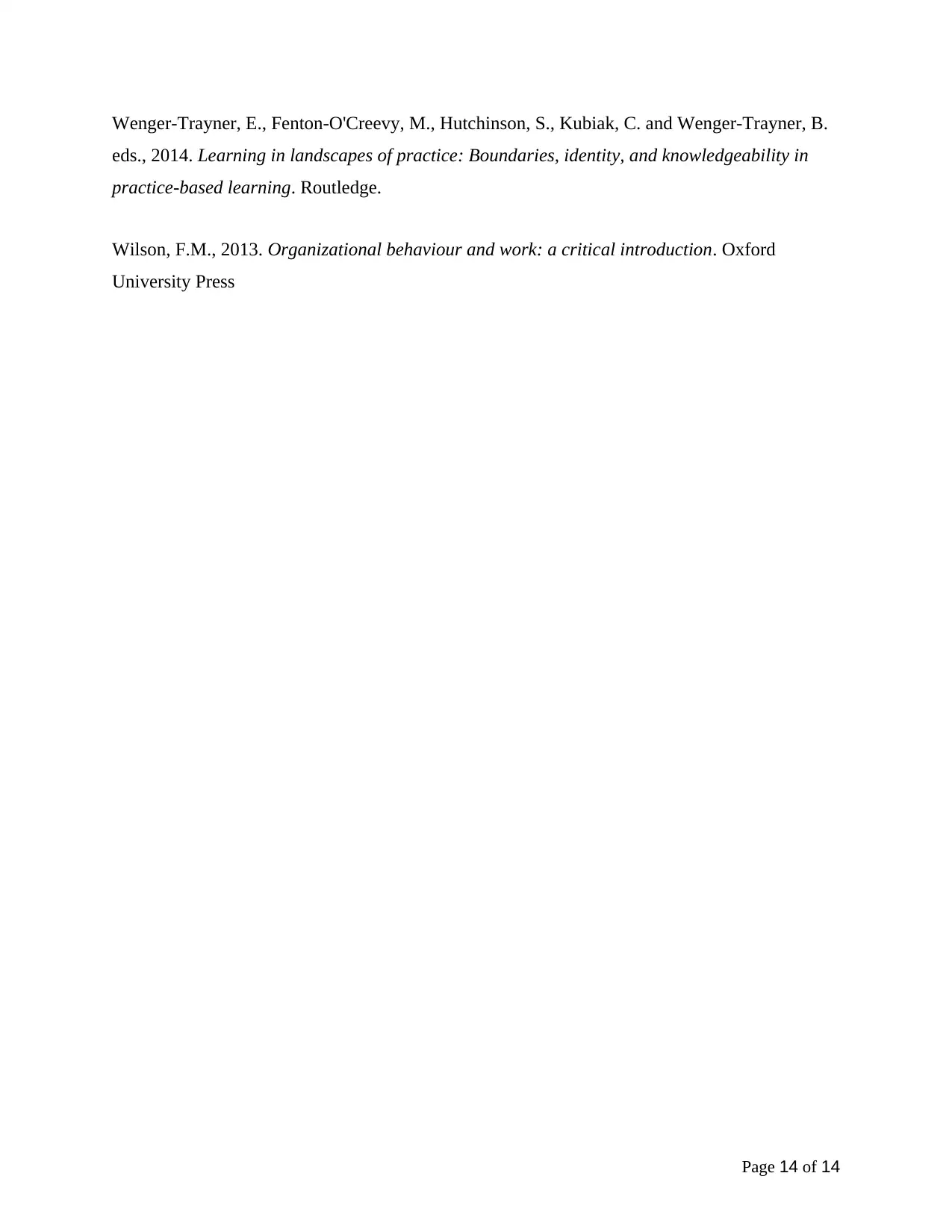
Wenger-Trayner, E., Fenton-O'Creevy, M., Hutchinson, S., Kubiak, C. and Wenger-Trayner, B.
eds., 2014. Learning in landscapes of practice: Boundaries, identity, and knowledgeability in
practice-based learning. Routledge.
Wilson, F.M., 2013. Organizational behaviour and work: a critical introduction. Oxford
University Press
Page 14 of 14
eds., 2014. Learning in landscapes of practice: Boundaries, identity, and knowledgeability in
practice-based learning. Routledge.
Wilson, F.M., 2013. Organizational behaviour and work: a critical introduction. Oxford
University Press
Page 14 of 14
1 out of 14
Related Documents
Your All-in-One AI-Powered Toolkit for Academic Success.
+13062052269
info@desklib.com
Available 24*7 on WhatsApp / Email
![[object Object]](/_next/static/media/star-bottom.7253800d.svg)
Unlock your academic potential
© 2024 | Zucol Services PVT LTD | All rights reserved.





